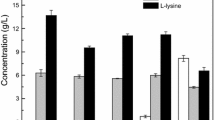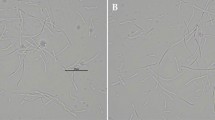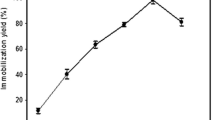Abstract
Sugar beet pulp (SBP) and molasses, as an agro industrial waste material, are produced in large amounts annually. Thus, a major challenge nowadays is to develop procedures that could increase the value of the generated waste. In this study, SBP as a support for cell immobilization and molasses as a source of nutrients were used for a dextransucrase (DS) production by Leuconostoc mesenteroides T3. The influence of SBP in native form (SBP-N) and after treatment with NaOH (SBP-NaOH) on DS production was investigated. The optimal medium composition for the maximum DS production was determined by varying the concentration of molasses, SBP, and sucrose. The maximum DS yield of 2.02 U/ml was obtained in the medium with 2.5 % of molasses, 2.5 % SBP-NaOH, and 4 % of sucrose concentration. Scanning electron microscopy (SEM) showed immobilization of Lc. mesenteroides T3 cells onto SBP-NaOH. According to the obtained results, the production of DS on molasses could be improved by using NaOH-treated SBP as a carrier for whole-cell immobilization. Our study reveals the basis for the development of process for DS production with additional reduction of expenses by using waste materials for obtaining the valuable biotechnological product.





Similar content being viewed by others
References
Nigam, P. (1994). Process selection for protein-enrichment: fermentation of the sugar industry by-products molasses and sugar beet pulp. Process Biochemistry, 29, 337–342.
Altundogan, H. S., Bahar, N., Mujde, B., & Tumen, F. (2007). The use of sulphuric acid carbonization products of sugar beet pulp in Cr (VI) removal. The Journal of Hazardous Materials, 144, 255–264.
Vučurović, V. M., & Razmovski, R. N. (2012). Sugar beet pulp as support for Saccharomyces cerivisiae immobilization in bioethanol production. Industrial Crops and Products, 39, 128–134.
Kühnel, S., Schols, H. A., & Gruppen, H. (2011). Aiming for the complete utilization of sugar-beet pulp: examination of the effects of mild acid and hydrothermal pretreatment followed by enzymatic digestion. Biotechnology for Biofuels, 4, 14.
Kelly, P. (1983). Sugar beet pulp—a review. Animal Feed Science and Technology, 8, 1–18.
Nigam, P., & Vogel, M. (1991). Bioconversion of sugar industry by-products—molasses and sugar beet pulp for single cell protein production by yeasts. Biomass and Bioenergy, 1, 339–345.
Vučurović, V. M., & Razmovski, R. N. (2012). Ethanol fermentation of molasses by Saccharomyces cerevisiae cells immobilized onto sugar beet pulp. Acta Periodica Technologica, 43, 325–333.
Mojović, LJ., Nikolić, S., Pejin, D., Pejin, J., Djukić-Vuković, A., Kocić-Tanackov, S. & Semenčenko, V. (2013). The potential for sustainable bioethanol production in Serbia: available biomass and new production approaches. Materials and processes for energy: communicating current research and technological developments In: Mendez-Vilas, A. (ed.). Formatex.
Mihajlovski, K., Radovanović, N., Veljović, Đ., Šiler-Marinković, S., & Dimitrijević-Branković, S. (2016). Improved β-amylase production on molasses and sugar beet pulp by a novel strain Paenibacillus chitinolyticus CKS1. Industrial Crops and Products, 80, 115–122.
Pervez, S., Aman, A., Iqbal, S., Siddiqui, N. N., & Qader, S. A. U. (2014). Saccharification and liquefaction of cassava starch: an alternative source for the production of bioethanol using amylolytic enzymes by double fermentation process. BMC Biotechnology, 14, 49–60.
Lopretti, M., Martinez, E., Torres, L., Perdomo, R., Santos, M., & Rodrigues, A. E. (1999). Influence of nitrogen: carbon ratio and complementary sugars on dextransucrase production by Leuconostoc mesenteroides NRRL B512(f). Process Biochemistry, 34, 879–884.
Leemhuis, H., Pijning, T., Dobruchowska, J. M., van Leeuwen, S. S., Kralj, S., Dijkstra, B. W., & Dijkhuizen, L. (2013). Glucansucrases: three-dimensional structures, reactions, mechanism, α-glucan analysis and their implications in biotechnology and food applications. Journal of Biotechnology, 163, 250–272.
Majumder, A., Purama, R. K., & Goyal, A. (2007). An overview of purification methods of glycoside hydrolase family 70 dextransucrase. Indian Journal of Microbiology, 47, 197–206.
Neely, W. B., & Nott, J. (1962). Dextransucrase, an induced enzyme from Leuconostoc mesenteroides. Biochemistry, 1, 1136–1140.
Santos, M., Rodrigues, A., & Teixeira, J. (2005). Production of dextran and fructose from carob pod extract and cheese whey by Leuconostoc mesenteroides NRRL B512(f). Biochemical Engineering Journal, 25, 1–6.
Mehvar, R. (2000). Dextrans for targeted and sustained delivery of therapeutic and imaging agents. The Journal of Controlled Release, 69, 1–25.
Naessens, M., Cerdobbel, A., Soetaert, W., & Vandamme, E. (2005). Leuconostoc dextransucrase and dextran: production, properties and applications. Journal of Chemical Technology and Biotechnology, 80, 845–860.
Lacaze, G., Wick, M., & Cappelle, S. (2007). Emerging fermentation technologies: development of novel sourdoughs. Food Microbiology, 24, 155–160.
Sen, R. (2008). Biotechnology in petroleum recovery: the microbial EOR. Progress in Energy and Combustion Science, 34(6), 714–724.
Queiroz, J. H. D., & Maugerio Filho, F. (1989). Optimization of the production of dextransucrase from Leuconostoc mesenteroides using molasses as carbon source. Revista De Microbiologia, 20(2), 150–156.
Vettori, M.H.P.B., de Lima, C.J.B. & Blanco, K.C. (2012). Performance of response surface model for increase of dextransucrase production by Leuconostoc mesenteroides FT 045B. Asian Journal of Biological and Life Science, 1.
Abedin, R. M. A., El-Borai, A. M., Shall, M. A., & El-Assar, S. A. (2013). Optimization and statistical evaluation of medium components affecting dextran and dextransucrase production by Lactobacillus acidophilus ST76480.01. Life Science Journal, 10, 1746–1753.
Davidović, S., Miljković, M., Antonović, D., Rajilić-Stojanović, M., & Dimitrijević-Branković, S. (2015). Water kefir grain as a source of potent dextran producing lactic acid bacteria. Chemical Industry, 69, 595–604.
Tsuchiya, H. M., Koepsell, H. J., Corman, J., Bryant, M. O., Geger, V. H., & Jackson, R. W. (1952). The effect of certain cultural factors on production of dextransucrase by Leuconostoc mesenteroides. Journal of Bacteriology, 64, 521–526.
AOAC. (2000). Official methods of analysis of AOAC International. Methods 955.04, 960.39, 982.14, 17th ed. AOAC International, Gaithersburg, MD, USA (2000).
NMKL 6. (2003). 4th ed. Nitrogen. Determination in foods and feeds according to Kjeldahl.
EG method. (2009). Commission Regulation (EC) No 152/2009 of 27 January 2009. Official Journal of the European Union.
Miller, G. L. (1959). Use of dinitrosalicylic acid reagent for determination of reducing sugars. Analytical Chemistry, 31, 426–429.
Sharma, N., Mahajan, S., & Sharma, N. (2013). Evaluation of different pretreatments versus forest wood waste and its selection as a solid substrate for enhanced cellulase production by Paenibacillus mucilaginous B5. Asian Journal of Experimental Biological Sciences, 4, 226–236.
Djukić-Vuković, A., Mojović, L., Jokić, B., Nikolić, S., & Pejin, J. (2013). Lactic acid production on liquid distillery stillage by Lactobacillus rhamnosus immobilized onto zeolite. Bioresource Technology, 135, 454–458.
Miljkovic, G.M., Davidovic, Z.S., Mladenovic, D.D., Mihajlovski, R.K., Dimitrijevic-Brankovic, I.S. & Siler-Marinkovic, S. Molasses and sugar beet pulp as a fermentation media for dextransucrase production by Leuconostoc mesenteroides T3, In: Radoje V. Pantovic, Z.S.M., (ed.).X International symposium on recycling technologies and sustainable development, 2015. Hotel Albo, Bor, Serbia. University of Belgrade-Technical Faculty in Bor, 127–132.
Razmovski, R. N., & Vučurović, V. M. (2012). Bioethanol production from sugar beet molasses and thick juice using Saccharomyces cerevisiae immobilized on maize stem ground tissue. Fuel, 92(1), 1–8.
Baker, P. E., & Ajongwen, N. J. (1991). The production of the enzyme dextransucrase using nonaerated fermentation techniques. Biotechnology and Bioengineering, 37, 703–707.
Qader, S. A. U., Aman, A., & Azhar, A. (2011). Continuous production of dextran from immobilized cells of Leuconostoc mesenteroides KIBGE HA1 using acrylamide as a support. Indian Journal of Microbiology, 51(3), 279–282.
Quirasco, M., Remaud-Simeon, M., Monsan, P., & Lόpez-Munguía, A. (1999). Experimental behavior of a whole cell immobilized dextransucrase biocatalyst in batch and packed bed reactors. Bioprocess Engineering, 20, 289–295.
Teixeira, M. S. J., & Rodrigues, A. (2000). Production of dextransucrase, dextran and fructose from sucrose using Leuconostoc mesenteroides NRRL B512(f). Biochemical Engineering Journal, 4, 177–188.
Purama, R. K., & Goyal, A. (2008). Screening and optimization of nutritional factors for higher dextransucrase production by Leuconostoc mesenteroides NRRL B-640 using statistical approach. Bioresource Technology, 99, 7108–7114.
Shukla, S., & Goyal, A. (2011). Optimization of fermentation medium for enhanced glucansucrase and glucan production from Weissella confusa. Brazilian Archives of Biology and Technology, 54(6), 1117–1124.
Das, D., & Goyal, A. (2014). Isolation, purification and functional characterization of glucansucrase from probiotic Lactobacillus plantarum DM5. Annals of Microbiology, 64(4), 1715–1724.
Behravan, J., Seddigheh Fazly Bazzaz, B., & Salimi, Z. (2003). Optimization of dextran production by Leuconostoc mesenteroides NRRL B-512 using cheap and local sources of carbohydrate and nitrogen. Biotechnology and Applied Biochemistry, 38(3), 267–269.
Vedyashkina, T. A., Revin, V. V., & Gogotov, I. N. (2005). Optimizing the conditions of dextran synthesis by the bacterium Leuconostoc mesenteroides grown in a molasses-containing medium. Applied Biochemistry and Microbiology, 41, 361–364.
Chagas, C. M. A., Honorao, T. L., Pinto, G. A. S., Maia, G. A., & Rodrigues, S. (2007). Dextransucrase production using cashew apple juice as substrate: effect of phosphate and yeast extract addition. Bioprocess and Biosystems Engineering, 30, 207–215.
Acknowledgments
The financial support for this investigation given by the Ministry of Education, Science and Technological Development of Republic of Serbia under the project TR 31035 is gratefully acknowledged. The authors would also like to thank Nordic Sugar from Denmark for providing a material for research.
Author information
Authors and Affiliations
Corresponding author
Electronic supplementary material
Below is the link to the electronic supplementary material.
ESM 1
(DOCX 111 kb)
Rights and permissions
About this article
Cite this article
Miljković, M.G., Davidović, S.Z., Carević, M.B. et al. Sugar Beet Pulp as Leuconostoc mesenteroides T3 Support for Enhanced Dextransucrase Production on Molasses. Appl Biochem Biotechnol 180, 1016–1027 (2016). https://doi.org/10.1007/s12010-016-2149-x
Received:
Accepted:
Published:
Issue Date:
DOI: https://doi.org/10.1007/s12010-016-2149-x




